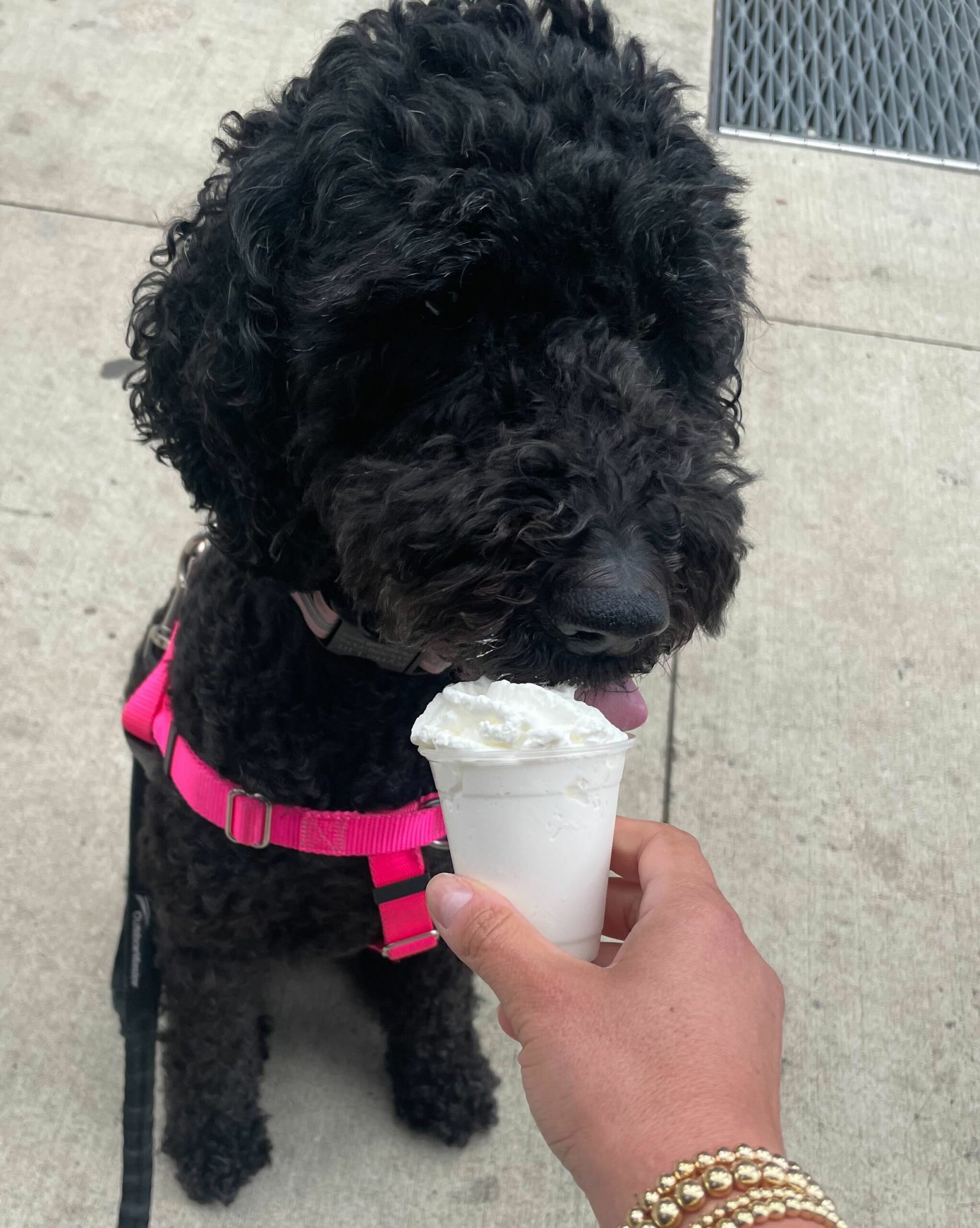Sometimes, you and your pup deserve an indulgent treat.
So, when you roll up to your local Starbucks and order your iced grande sugar-free vanilla soy latte, you throw in a puppuccino (aka ‘pup cup’) for your pooch.
But are puppuccinos actually healthy, or even safe for our furry friends to enjoy—or are you better off sticking to Milk Bones?
We’ve whipped up a deep dive on this sweet treat, and asked Dr. Stephanie Liff, Lemonade’s favorite vet (and proud Starbucks enthusiast) to weigh in.
- Plain whipped cream is absolutely safe for dogs to eat, in moderation.
- If your dog has a dairy sensitivity, pancreatitis, or is at risk for canine obesity, puppuccinos probably aren’t the ideal treat for them.
- Dogs can actually enjoy a taste of many Starbucks menu items, as long as they don’t contain grapes, raisins, or chocolate.
- Some sugar-free whipped cream products could contain xylitol, which is toxic to dogs.
What is a puppuccino?
A Starbucks puppuccino’s beauty is in its simplicity: an espresso cup filled with whipped cream. Fin.
The puppuccino was born in 2008 by animal rescue advocate and former Starbucks barista Rocky Kanaka, who started offering the simple, delicious treat to enthusiastic dogs at his store. The rest is history.
Puppuccinos became an official “secret” menu item at Starbucks in 2015, and are still 100% free of charge.
It wasn’t long before other franchises got on the pup-treat bandwagon. Besides Starbucks, you can pick up a variation of a puppuccino at Dunkin’ donuts, Caribou Coffee, the Coffee Bean, Dairy Queen, Culver’s, and more.
Is whipped cream bad for dogs?
According to Dr. Liff, puppaccinos are a totally fine for your dog’s health, as are most dairy products.
In fact, her Labraddodle Kyrie enjoys a puppucino almost every day. We even have proof.

Like any treat, Dr. Liff recommends puppuccinos be offered as an occasional indulgence. The average Starbucks puppuccino includes 1–2 ounces of whipped cream, which is safe for most dogs, no matter their size.
And while Kyrie won’t leave Starbucks before she gets her daily fix, Dr. Liff recommends that you give your dog a puppucino on a less frequent basis, as they are a “high-value treat,” and have a much higher fat content than typical dog food.
Basically, puppuccinos are the canine equivalent of a caramel ribbon crunch frappuccino. Worth it as reward… just not every day.
Are some dogs bothered by whipped cream, though?
While whipped cream isn’t toxic to dogs, it doesn’t mean it will necessarily sit… well with them.
If your dog experiences an upset stomach, bloating, vomiting, or diarrhea after enjoying a puppuccino, they might have a sensitivity to high-fat treats or may be lactose intolerant. Also, if your dog has a history of pancreatitis, or is at risk for canine obesity, or other health issues, a puppuccino probably isn’t the right “drink” for them.
What about other Starbucks snacks?
If you’re wondering if you can split a different Starbucks treat or pastry with your pooch, Dr. Liff confirms that you can safely share a nibble (but not much more than that!) of most Starbucks menu items with your dog, as long as it doesn’t include grapes, raisins, or chocolate. We have on good authority that doggos really dig those egg white bites.
Long story short: When it comes to serving your pup delicious “human food”, moderation is the name of the game. Want to learn more? Get the full scoop on your dog’s diet.
What about low-calorie whipped topping?
If you’re recreating a puppuccino at home, you might think that a dollop of Cool Whip might be a healthier alternative for your pup, as opposed to full-fat heavy whipped cream.
And that would be fine—but you’re not necessarily doing your pup any favors.
When looking at human treats to give to offer to your dog, read the ingredients to find which sweetener is used. Cool Whip uses high fructose corn syrup, which isn’t toxic to dogs, but definitely isn’t good for them. Sugar-free Cool Whip uses NutraSweet, which is derived from stevia, and is also non-toxic to dogs, but could upset their tummy in large quantities.
Sucralose (the sweetener in Splenda) and xylitol, on the other hand, are toxic to dogs and should be avoided. When consumed in large quantities xylitol can cause a potentially dangerous drop in blood sugar levels, as well as seizures, vomiting, and diarrhea.
Keep treats containing xylitol (like most peanut butter, many puddings, and a wide array of “sugar-free” products) off the menu.
TL;DR—when treating your pup, go with the real stuff.
Before we finally sit, stay, and get a treat…
Spoiling your pooch is one of the most enjoyable parts of being a pet parent. As long as you allow your pup to indulge in habits that are safe and good for their overall health and happiness, we’re on board (unless it’s a squeaky toy, those things are annoying).
It might not be as delicious as a puppucino, but pet insurance is another way you can spoil your pet with the care they need. Lemonade pet insurance for dogs is customizable, affordable, and can even help animals in need via Lemonade’s Giveback program. Pretty sweet, right?
A few quick words, because we <3 our lawyers: This post is general in nature, and any statement in it doesn’t alter the terms, conditions, exclusions, or limitations of policies issued by Lemonade, which differ according to your state of residence. You’re encouraged to discuss your specific circumstances with your own professional advisors. The purpose of this post is merely to provide you with info and insights you can use to make such discussions more productive! Naturally, all comments by, or references to, third parties represent their own views, and Lemonade assumes no responsibility for them. Coverage and discounts may not be available in all states.




